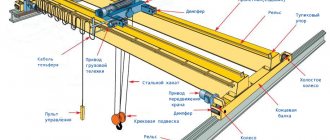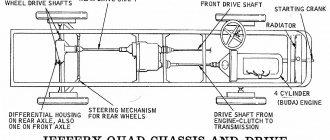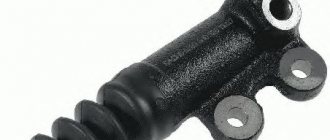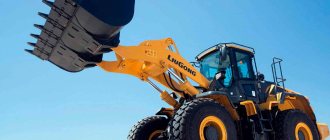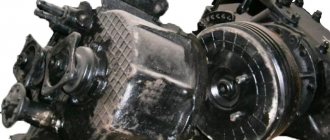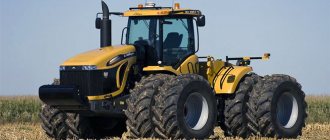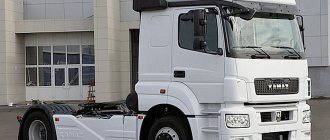Good afternoon, dear reader.
This article will discuss the location of trucks on the roadway. The fact is that traffic rules impose special requirements on trucks when choosing a lane.
Let's look at which lanes trucks can move in, as well as the fines for improperly positioning a vehicle on the roadway:
- Classification of trucks in traffic regulations.
- Truck traffic in populated areas.
- Selecting a lane outside a populated area.
- Truck traffic on highways.
- What lanes can trucks use on the Moscow Ring Road?
- Fines for incorrect lane selection.
Classification of trucks in traffic regulations
First of all, I would like to note that traffic regulations for trucks provide for various layout options depending on the permitted maximum weight. In this case, trucks are divided into 3 groups :
- Up to 2.5 tons inclusive (category B).
- From 2.5 tons, up to 3.5 tons inclusive (category B).
- More than 3.5 tons (category C).
Basic Rules
Movement using motor vehicles, regardless of the type of cargo, is subject to established rules. Upon closer examination, security measures differ slightly for each type of cargo.
Thus, for the transportation of goods considered long, a limit has been set - the length of the cargo should not exceed the dimensions of the vehicle by more than a third. Length control ensures safe vehicle movement. If the length is exceeded, the load may be heavier than the car, which will lead to an emergency.
Transportation of long and heavy cargo is safe if generally accepted conditions are met:
- the cargo limit corresponds to the capacity of the car;
- heavy elements are located “in the head” of the machine;
- light cargo is located in the upper part of the body;
- speed control.
These conditions apply to the transfer of any luggage.
Truck traffic in populated areas
Let's consider paragraph 9.4 of the traffic rules:
In populated areas, taking into account the requirements of this paragraph and paragraphs 9.5, 16.1 and 24.2 of the Rules, vehicle drivers can use the lane that is most convenient for them. In heavy traffic, when all lanes are occupied, changing lanes is only allowed to turn left or right, make a U-turn, stop, or avoid an obstacle.
However, on any roads that have three or more lanes for traffic in a given direction, the leftmost lane is allowed to occupy only in heavy traffic, when other lanes are occupied, as well as for turning left or making a U-turn, and for trucks with a permissible maximum weight of more than 2.5 t – only for turning left or making a U-turn. Entering the left lane of one-way roads to stop and park is carried out in accordance with paragraph 12.1 of the Rules.
In populated areas there is a restriction for trucks with a permissible maximum weight of more than 2.5 tons . On roads with three or more lanes, such trucks may occupy the leftmost lane only for left turns and U-turns.
Please note that this restriction also applies to category B trucks. For example, many pickups (Mitsubishi L200, Volkswagen Amarok, Toyota Hilux) can only enter the leftmost lane for left turns and U-turns.
Otherwise, the requirements for trucks in a populated area are the same as for all other vehicles. On roads with two lanes, you can occupy any lane; on roads with three or more lanes, you can occupy any lane except the leftmost one.
Prohibited maneuvers
Transportation safety is affected by following the rules. However, not all carriers treat this responsibly. When transferring any cargo it is unacceptable:
- allow the vehicle to be overloaded;
- transport people in a vehicle that is not equipped for this;
- to ensure that a driver taking medications that affect psychomotor functions recovers for the trip.
The same list can include exceeding the speed limit, not having a fire extinguisher, and much more.
Selecting a lane outside a populated area
Paragraph 9.4 of the traffic rules:
9.4. Outside populated areas, as well as in populated areas on roads marked with signs 5.1 or 5.3 or where driving at a speed of more than 80 km/h is permitted, vehicle drivers must drive them as close as possible to the right edge of the roadway. It is prohibited to occupy the left lanes when the right lanes are free.
However, on any roads that have three or more lanes for traffic in a given direction, the leftmost lane is allowed to occupy only in heavy traffic, when other lanes are occupied, as well as for turning left or making a U-turn, and for trucks with a permissible maximum weight of more than 2.5 t – only for turning left or making a U-turn. Entering the left lane of one-way roads to stop and park is carried out in accordance with paragraph 12.1 of the Rules.
Outside populated areas, drivers of all vehicles should not occupy the left lanes when the right lanes are free, i.e. Truck drivers should drive in the right lane first. And only if the right lane is busy, you can move into the second lane:
In addition, if the road has 3 or more lanes in a given direction, then trucks weighing more than 2.5 tons can enter the left lane only for left turns and U-turns.
Rice. 1. The driver’s seat behind the steering wheel: a - correct; b - incorrect
The work of an unrested driver is a safety hazard, especially at night. A tired driver is much more susceptible to blinding and has a longer reaction time. Finally, in the morning he may involuntarily fall asleep at the wheel.
Clean cockpit windows, correct installation of headlights, serviceable windshield wipers, and effective blowing of warm air onto the windshield create conditions for good visibility and reduce visual strain.
It should also be taken into account that cooling the body and a state of hunger make the driver more susceptible to blindness. Therefore, warm clothing, proper heating of the cabin and timely eating are essential factors in preventing road accidents.
Feeling drowsy, the driver should stop the car, get out of the cab, rest, freshen up and make several sudden movements; if this helps, you can continue driving; if not, you need to take the car off the road and rest.
Before starting work, the driver, in addition to checking the technical condition of the vehicle, must personally verify the availability and serviceability of the tool kit. When going on long trips by car, you need to take a tow rope, a shovel, an ax, and in winter, snow chains.
When driving a car, you must keep both hands on the steering wheel; you can remove your hand only in the following cases: turning on and changing gears; turning devices on and off; lowering and raising the side window; hand or door alarms; monitoring the road through an open door when reversing.
You need to brake the car by smoothly pressing the brake pedal with your right foot, and when stopping, you need to fix the position of the car with the parking brake. When starting on an incline, the parking brake should be released as soon as the vehicle begins to move in order to prevent it from rolling away.
The rear view mirror must provide observation of the road behind the car; if the mirror is located inside the car, the rear window of the cab (body) must not be blocked.
Driving a car on and off the road. Before a flight along a previously unexplored route, it is necessary to familiarize yourself with the terrain, paying special attention to dangerous areas, and draw up a schedule so that you can pass them during daylight hours. Studying the area on a map using conventional signs, they evaluate the possibility of vehicles moving along a particular road and choose the route that is most convenient for movement, even if it is longer.
Rice. 2. Hand position on the steering wheel
It is necessary to take into account driving conditions depending on the time of year, the amount of precipitation and the weather forecast. For example, dirt roads in wooded and swampy areas can only be used during the dry season. Driving on dirt roads during drought is difficult due to dust, which will reduce the speed of movement. In mountainous areas, driving at any time of the year is possible only on roads.
Sometimes the route goes off-road. In this case, to determine your location, you need to orient the map using a compass. To eliminate the influence of the large mass of metal on the car on the compass readings, the compass readings must be taken by moving 5-6 m away from the car.
After 1-1.5 hours of driving, you should stop the car for personal rest, conduct a control inspection of the car and the condition of the cargo.
Before overcoming difficult areas, you should stop the car for additional checks and carry out work to ensure that the obstacle can be overcome in one go (put on snow chains, check the condition of the bridge, etc.). When driving in such areas, it is not recommended to disengage the clutch or change gears; The gears necessary to overcome the dangerous section without stopping should be turned on in advance.
Driving conditions on highways require reliable adhesion of tires to the road surface at high speeds. A rough concrete surface meets this requirement. Smooth road surfaces reduce traction and can form a layer of liquid that reduces tire grip. Bitumen appears on the surface of a repaired road with asphalt-concrete pavement; this coating has less traction with the tires; the danger increases if it is wetted by rain or watered, since bitumen with water forms a layer of “lubricant”, and adhesion is sharply reduced.
The condition of the road surface greatly influences the change in its coefficient of adhesion. The moisture content of a rough coating reduces the adhesion coefficient by 1/3, and on a smooth coating - up to 1/2 or more.
Contamination of the road surface with soil or dust reduces the coefficient of adhesion, especially at the beginning of rain, when the soil turns into a liquid film.
Icy conditions are the most dangerous for driving, as the adhesion qualities of the road surface are reduced to a minimum.
On some sections of roads where traffic patterns often change (at intersections, footpaths, on slopes), the road surface wears out and is sanded, which worsens its grip qualities,
On forest roads, the slipperiness of their surface increases during leaf fall.
The grip of tires on the road depends not only on its surface, but also on the condition of the tires. The traction force is greatly influenced by the tread pattern. A good pattern when driving on a wet road should squeeze out and remove moisture, ensuring movement on a dry surface, however, when driving at high speeds, due to the short contact of the tire with the road surface, the moisture is not completely squeezed out and the tire's grip when driving at a speed of 100 km/h can decrease by half compared to dry coating.
Due to tread wear, grip decreases sharply. So, when driving at a speed of about 80 km/h on a wet road, the traction of a tire with a worn tread decreases sharply, as the tire moves on a liquid film, and the car may become uncontrollable.
The air pressure in all car tires must comply with the standards. As the pressure decreases, the tire's grip on the road surface increases, but its service life sharply decreases. A tire with increased pressure has a smaller contact area with the road, and therefore a lower coefficient of adhesion. Tires with different pressures sharply increase the risk of the car skidding due to non-simultaneous blocking of the wheels during braking.
When moving on a slippery road, the driver is obliged to drive the car at a reduced, uniform speed, avoiding sudden changes, braking and turns.
The driver's awareness of the road and surroundings depends on visibility and visibility. Visibility varies depending on the time of day, atmospheric conditions, street lighting, distance to the vehicle in front and road profile.
Visibility becomes limited when approaching the top of a hill or curve in the road, requiring the driver to reduce speed and stay in the far right lane to avoid the possibility of hitting oncoming vehicles traveling out of sight.
In fog, rain, snowfall, or dust, the driver is obliged to ensure traffic safety by reducing speed so that the danger can be seen within sight and the car can be stopped. If visibility becomes less than 300 m while driving in these conditions, or when driving in tunnels, you should turn on low beam headlights. On dusty roads, it is necessary to increase the distance to the car in front, since visibility in the dust raised by it is sharply reduced.
Visibility depends on the design of the vehicle. On modern cars, to improve it, panoramic (curved) windshields are installed, thereby increasing the driver’s field of vision.
If another car moves uncertainly or moves from one lane to another, the driver is obliged to take precautions and reduce speed, as there may be an inexperienced or drunk driver there. The same applies to pedestrians: if a large number of pedestrians are moving confidently, you can move at normal speed, but the appearance of one drunk on the roadway is enough to require an immediate stop of the car.
Rice. 3. Restricted visibility on a road with a sharp bend in the longitudinal profile
In the mountains, where the roads have many sharp turns, long ascents and descents, the driver is obliged to especially carefully monitor the technical condition of the car, since the slightest malfunction can lead to more dangerous consequences than on the plain. A vehicle constantly operating in the mountains must be equipped with devices to hold it in place if it stops on a slope. The simplest devices are shoes, wedges or blocks placed under the wheels of the car.
Driving on mountain roads requires certain skills from the driver.
When approaching a sharp turn or a series of turns (serpentines), the driver must remember that behind each sharp turn there may be an invisible obstacle—a stopped or moving car, a section of road being repaired, and others. When approaching a sharp turn, the driver must reduce speed in order to, if necessary, stop the car within sight, sound the horn during the day, and at night change the intensity of the headlights and go through the turn, as shown in Fig. 5.
To overcome a steep climb, the driver must engage in advance one of the lower gears, which ensures that the climb can be completed without changing gears. You must not negotiate a steep climb until the vehicle in front has reached the top or the oncoming vehicle has completed its descent.
Rice. 4. Shoes, wedges and pads placed under the wheels of cars on a slope
On steep descents on mountain roads, the driver is prohibited from driving with the clutch or gear disengaged. You need to descend in one of the lower gears, which ensures effective engine braking, periodically using the foot brake.
Wooden bridges on country and field roads that do not have “Weight Limit” signs in front of them must be driven carefully. On the bridge deck you must drive the car smoothly, without changing gears, without jerking or sudden braking. If you are crossing a bridge for the first time, you need to check its reliability. The load-bearing capacity of a bridge is determined by the thickness and condition (presence of rot and other damage) of piles, caps, purlins, and decking.
In tunnels, the driver must follow certain rules. In cities, even if the tunnels are large, well lit and designed to accommodate a large number of vehicles, low beam headlights must be turned on. It is prohibited to stop in the tunnel and overtake other vehicles leaving the occupied lane.
Driving on dry country roads does not cause any particular difficulties, although on such roads, even with slight traffic, the driver has no right to reduce attention or exceed speed, especially when approaching closed turns.
Rice. 5. Serpentine roads
Rice. 6. Determination of bridge load capacity
Dry deep ruts can damage tires and should be avoided. It is better to overcome deep potholes, ditches and other similar obstacles at right angles at a reduced speed to reduce deformation of the frame or body. Before an obstacle, slow down, and at the moment of overcoming it, vigorously press the throttle pedal, which will help you get onto a flat road due to the inertia of the car.
To eliminate the possibility of the lower part of the body or the buffer touching the edge of the ditch, you need to choose flatter places or first remove the soil with a shovel. If water or dirt has accumulated at the bottom of the ditch, you need to pave the bottom with improvised materials or earth.
On a wet clay road with an old track, you need to move, passing the track between the wheels in order to avoid stopping in the soggy ground. You can drive on the new track, since the layer of dirt in it is small and there is less resistance to movement. When the vehicle is not fully loaded and driving through shallow mud, the outer slopes of the rear wheels can be removed, and the single drive wheels will push the layer of mud down to solid ground, which will provide sufficient traction. Sections of the road with deep mud must be overcome in low gears at high engine speeds. To make it easier to drive through this section, you can place boards and poles under the drive wheels. To make it easier for the car to get out of the mud, you need to clear the path for the front wheels.
When moving along arable land with furrows or overcoming small hollows and shallow ruts, the car should be launched at an acute angle towards them, which reduces the transmission of shocks from these obstacles.
A section of the road flooded with water must first be scouted, as there may be holes or large stones there, and drive through it at low speed.
You need to move along a dry meadow at such a speed that shocks from uneven soil do not affect the condition of the car. When driving through a swampy area, you must try to maintain a layer of turf; if it is damaged, the wheels will fail and the car will get stuck. In this case, you must not allow slipping, and if you get stuck, you must hang the car and put brushwood, logs, and poles under the wheels.
When choosing the direction of movement, avoid sharp turns and pay attention to the grass cover: bright green tall vegetation indicates weak turf, flat, short grass indicates relatively strong soil. In swampy areas, you cannot follow the trail of a passing vehicle, since the turf layer is weakened.
It is better to avoid an area with fine dry sand in dry weather. A stopped car must be hung out and a metal mesh or boards, logs, or brushwood placed under the wheels. You can move on wet sand without fear: it is well compacted and the wheels almost do not get stuck in it.
If there is only one headlight on the car (in case of damage during travel), it should be on the left side.
When stopping on an unlit road, you must turn on the side or parking lights; if they malfunction, the vehicle must be moved off the road.
Road trains differ from single vehicles in their greater length, weight, turning radius and braking distance. Therefore, driving a road train is more difficult, and the driver must follow certain rules.
You need to accelerate in each gear so that when shifting, the engine power is sufficient to drive in a higher gear; you should change gears quickly.
The speed of the road train must ensure smooth braking when stopping. When overcoming a hill, you must engage a gear that allows you to reach the top of the hill without shifting, and before descending, reduce the speed to a safe one. You need to brake on a descent without disengaging the clutch.
You should not brake when overcoming obstacles (potholes, dug up places); it is better to coast through them.
In the case of passing on a narrow road and before sharp turns, you need to reduce the speed in advance, and at the moment of passing or passing a turn, increase the speed, drive the road train so as to prevent the trailer from rolling onto the tractor (pulling).
To stop the road train, choose a flat area with a hard surface. If you stop on a dirt road with sticky or loose soil, the tractor will not be able to move the road train, and its wheels may become buried.
Before fording streams and small rivers, you need to check the depth of the ford and the hardness of the soil. The banks should not be steep, but flat, so that they do not impede movement. After checking the ford, you should set landmarks - landmarks. For passenger cars, the ford depth should not exceed 0.5 m, and for trucks - 0.7-0.8 m.
Before wading, close the blinds and remove the fan belt. You need to go down to the water and cross the ford slowly in one of the lower gears at medium engine speeds, without stopping. Rivers and streams with fast currents must be driven diagonally along the current. Having crossed the ford, you need to drive a certain distance with the brake pedal pressed to dry the brake mechanisms.
You can only enter the ferry with permission from the ferryman at low speed. On the ferry, it is necessary to evenly distribute the load, avoiding excessive maneuvering.
In severe frosts, it is also necessary to pay attention to the driver’s clothing, cabin insulation and serviceability of the heating system and windshield blower, the quality of the brake fluid in the hydraulic brake drive, and preventing condensate from freezing in the pneumatic brake drive.
Heavy snowfall requires a reduction in speed due to a sharp decrease in visibility and the appearance of snow cover on the roadway, worsening driving conditions and increasing braking distances.
On a packed snow road you should drive at a moderate speed, as a layer of compacted snow reduces traction and increases braking distance. You should not drive your front wheels into the snow on the side of the road, as the car may be pulled off the road.
Small snowdrifts are overcome with acceleration, using the inertia of the car. If the snowy section is long, you need to engage a gear in advance, which will ensure that you can overcome it without stopping. A stopped car should be pulled back along the track and accelerated forward. When wheels slip, you need to clear the snow in front of them and add brushwood or sand.
You should pass an oncoming vehicle on narrow snowy roads at low speed or, having chosen a place, stop and let it pass.
Increase the cross-country ability of vehicles using snow chains. To put chains on the wheels, they are laid out in front or behind along the track of the car and carefully driven into the middle of the chains, the chains are tensioned and the ends are connected with a lock. Snow chains can be fine-linked, track-type, or track-type.
Chains are installed only to overcome difficult terrain; when driving on paved roads, they accelerate tire wear and increase fuel consumption. In the absence of special means to overcome such areas, improvised materials are used - logs, poles, boards, brushwood, crushed stone, slag.
A car equipped with a winch can pull another car, provided that it is on solid ground and is securely braked, and the winch is operating in first gear of the power take-off at medium engine speeds. For self-pulling with a winch, it is necessary to securely fasten the cable to a stump or tree, and if this is not available, use a stop, which can be a log dug into the ground or a crowbar driven into the ground.
Crossing on ice is possible only after reconnaissance of the thickness and condition of the ice cover (absence of polynyas and large cracks), as well as determining the state of the interface of the ice cover with the shores, which, if necessary, is reinforced with shields.
You should drive onto the ice carefully, without impacts, move at the crossing at a speed of 10-15 km/h, keeping a distance between cars of at least 25-35 m. Only the driver can be in the cab, and both doors must be open.
Traffic on the streets of large cities is characterized by a wide variety of maneuvers, intensity and frequent changes in speed. The driver must perfectly navigate this complex environment and quickly make the right decisions to ensure traffic safety. The distance between vehicles on the streets is reduced compared to country roads, which requires increased driver attention and reduced speed.
Rice. 7. Small-link snow chains: a - for single wheels; b - for dual wheels; c - mounted on car wheels
Rice. 8. Track snow chains: a - unfolded; b - mounted on car wheels
Before leaving for an intersection or square, the driver must determine the order of movement and only then drive through, remembering that the situation is complicated by the intersection of traffic flows with flows of pedestrians crossing the roadway, which often causes accidents in cities and towns.
The driver must take into account the condition and age of pedestrians and, with sufficient attention, can prevent danger. The most common violations of crossings: crossing in an unspecified place; crossing in front of a nearby vehicle; unexpected exit from behind a vehicle onto the roadway; children playing on the roadway.
A driver who underestimates one of these factors contributes to the creation of a dangerous situation. He must be constantly prepared for unfavorable changes in the situation and must strive to ensure safety, even with imprudent actions of other road users.
Maintaining the vehicle in good condition at all times ensures that the task can be completed at a speed that promotes safe driving, which can be maintained using correct driving techniques and a thorough understanding of the route.
Rice. 9. Track snow chains: a - unfolded; b - mounted on car wheels
Rice. 10. Determining the thickness of ice using a shovel: 1 - snow; 2 - snow ice; 3 - cloudy ice; 4 - transparent ice
An experienced driver calculates speed depending on the situation, achieving smooth movement without unnecessary braking, which reduces wear on the vehicle and increases operating speed.
High conscious discipline, constant improvement of driving techniques, knowledge and compliance with the Rules of the Road, keeping the car in good condition and constant attention to changes in the road situation are the main qualities of an advanced driver.
Truck movement on highways and roads for cars
The location of trucks on highways and roads for cars deserves special attention.
Paragraph 16.1 of the traffic rules:
16.1. On highways it is prohibited:
- movement of trucks with a permissible maximum weight of more than 3.5 tons beyond the second lane;
16.3. The requirements of this section also apply to roads marked with sign 5.3.
Heavier than 3.5 tons. On motorways, category C trucks can only drive in the two right-hand lanes. They cannot enter the remaining lanes under any circumstances.
From 2.5 to 3.5 tons. As for trucks from 2.5 to 3.5 tons, on highways they can move in any lanes except the far left (if there are 3 or more lanes in a given direction).
Up to 2.5 tons. There are no restrictions imposed on trucks with a permissible maximum weight of 2.5 tons or less.
Loading and unloading operations
When loading goods into a vehicle, following simple safety rules facilitates the task of distributing the cargo throughout the vehicle, ensuring the reliability of its location and fastening. Loading operations begin only if the cargo calculation has been completed. Control of the loading process, stowage of cargo, as well as the correctness of fastening is usually carried out by the driver of the vehicle and/or a representative of the transport organization with which the contract for the provision of transportation services has been concluded.
Even experienced personnel must be reminded of the rules for loading and unloading vehicles before starting work.
Unloading the vehicle requires no less attention. The driver or forwarder must also monitor the accuracy of unloading the goods and inspect them for damage and loss. There are also requirements for the safe implementation of loading and unloading operations (LOW):
- loading begins from the cabin to the rear of the car, and unloading begins on the contrary (from the end);
- maintaining a distance between the truck and residential buildings - at least 150 meters;
- When loading and unloading several vehicles, the distance between vehicles is at least 1 meter.
In general, concentration on the process and, of course, special equipment help to load and unload goods efficiently and without incident.
What lanes can trucks use on the Moscow Ring Road?
As an example, consider the movement of trucks along the MKAD , the Moscow ring road. The Moscow Ring Road is marked with sign 5.3, i.e. is a road for cars. In addition, it passes within the boundaries of a populated area. The permitted speed is 100 km/h. The road has at least 5 lanes in one direction.
1. Light trucks less than 2.5 tons . Such cars can theoretically occupy any lane. However, this can only be done during heavy traffic. If traffic is not heavy, drivers should occupy the right lanes and drive closer to the right edge of the roadway.
2. Trucks from 2.5 to 3.5 tons . These vehicles should also move as far to the right as possible. In addition, even in heavy traffic conditions, they should not occupy the far left lane. Those. For trucks from 2.5 to 3.5 tons, 4 right-hand lanes are available.
3. Trucks heavier than 3.5 tons . This group must comply with the most stringent conditions. Traffic is allowed only in two right lanes.
Driver safety
Ensuring a safe trip for the driver is one of the most important aspects in the field of cargo transportation by road.
Control of actions and control of the vehicle minimizes the occurrence of unplanned circumstances. The driver takes the main measures immediately before the flight. The driver needs to check:
- serviceability of the entrusted vehicle;
- health status (undergo a medical examination);
- documents for the trip (driver’s license, route sheet, permission to drive this car);
- papers for cargo (quality certificates, certificates, etc.);
- special protective clothing (if the specifics require this).
Another document that the driver must have with him and also know the contents (preferably memorized) is the safety and labor protection instructions. The best option would be to have the driver’s signature on the document.
Fines for wrong lane selection
| Violation | Article of the Administrative Code | Punishment |
| Driving a truck heavier than 3.5 tons beyond the second lane on a motorway | 12.11, part 2 | 1,000 rubles |
| Other violations of truck location rules | 12.15, part 1 | 1,500 rubles |
For example, a driver will receive this fine in the amount of 1,500 rubles if he drives a truck heavier than 3.5 tons further than the second lane on a road for cars (MKAD).
In addition, the movement of trucks is currently monitored by cameras operating in automatic mode. And if a truck drives 30-40 kilometers along the third lane of the Moscow Ring Road, then in a short period of time it will collect fines of 10-20 thousand rubles. Be careful and do not allow such violations.
Good luck on the roads!
Ensuring transport safety
Car safety is no less important when preparing a trip. Immediately before the trip, the driver checks the serviceability and readiness of the vehicle (this is part of his duties).
The prepared car must have:
- tools for urgent repairs;
- first aid kit;
- fire extinguisher (preferably two - in the cab and in the back).
Medicines and extinguishing agents have a warranty period of use and storage. All deadlines must be valid. If expired funds are found, the driver is issued a fine.
The process of preparing a car for a trip includes checking the quality of lubrication of connections, visual inspection, and monitoring the integrity of seals (for example, the junction of the body awning cable must be sealed).
The presence and amount of fuel in the gas tank also affects safety. Fuel should be poured into the tank carefully, without spilling. Spilled fuel is covered with sand or sawdust, cleaned from the surface (or swept away), or wiped dry with a clean rag.
Responsibility for offenses
Today, penalties for traffic offenses have been tightened. Drivers are monitored everywhere by inspectors and video cameras. Of course, each type must be considered separately, but we will look at a few penalties as an example:
- if a truck driver moves on the highway further than the second right lane, he faces a fine of 1,500 rubles;
- In some localities, driving under a “Prohibition for trucks” sign can be an expensive pleasure: in Moscow and St. Petersburg you will have to pay 5,000 rubles for this.
To drive under some signs, if necessary, you need to obtain a special permit. In general, travel on the country's roads for trucks is not much different from the movement of buses and cars. The driver must know all the nuances described above.
Preparing for the trip
Before traveling with a trailer, it is necessary to check its technical condition, since its malfunction can lead to disastrous consequences.
The first step is to check the serviceability of the towbar. The lock must function flawlessly, that is, it must be securely locked when closed. Do not forget about safety ropes and chains; they must be securely attached to the car.
The towbar (hitch ball) should be lubricated with graphite lubricant, which will reduce friction and improve electrical contact between the tow vehicle and the trailer.
The next step is to check the condition of the wheel bearings. To do this, you need to lift the side of the trailer and spin the wheel by hand. Don't forget to check the tire pressure - it should be the same. An important point is checking the condition of the shock absorbers.
If they malfunction, the trailer will toss from side to side on the road.
It would also be a good idea to check the operation of the trailer headlights. Sometimes the light bulbs may burn at half power or not at all.
Cargo placement
The load in the trailer will be placed in such a way that it is as low and close to the axle as possible. When loading, it is better to move the luggage forward a little than to reload the rear of the trailer.
But in any case, the trailer drawbar should not put pressure on the tow bar with a force of more than 50 kg.
When a trailer is overloaded, it lifts the rear of the vehicle, reducing the effectiveness of the rear brakes and overloading the front suspension. When the front of the trailer is overloaded, it lifts the front end of the vehicle. This leads to a decrease in control efficiency, and a front-wheel drive car will slip even on asphalt.
Basic rules for driving a car with a trailer
The rules for using a trailer are the same for each driver:
- First of all, you should take care of securing the trailer as securely as possible. Practice shows that the cause of an emergency situation, when the towed unit becomes detached at full speed, can be precisely the negligence of the car owner, who did not take care of securing it. It is best to attach a trailer after first reading the user manual for the specific design.
- The trailer's light signals must be in good working order, because in this case the role of the rear markers and turn signals will be played by the lights on the rear of the trailer. The connection of these elements with the on-board control panel must be reliably and correctly synchronized.
Thus, it is the quality and correctness of the connection of the trailer to the vehicle that determines the safety of all road users. Also, compliance with these simple rules will eliminate any conflicts with the traffic police that arise when checking a car or during an accident (even not through the fault of the trailer owner). Another simple rule for resolving issues related to the operation of a trailer on the road and ownership rights to it is mandatory registration with the registration department of the State Traffic Safety Inspectorate (SAI).
